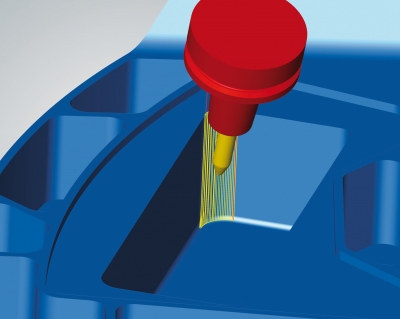
Open Mind Technologies AG has introduced hyperMILL 2019.1, a new version of its advanced, comprehensive CAD/CAM software suite. hyperMILL 2019.1 has a range of new features and enhancements including an expanded Finishing Module in the hyperMILL MAXX Machining Performance Package, process optimizations such as a new thread milling module, a new function for reducing calculation times, tool database flexibility, and CAD optimization.
“We’re very pleased to launch 2019.1 hyperMILL,” said Alan Levine, managing director of OPEN MIND Technologies USA Inc. “We have expanded functions that offer even further improvements for cycle time reductions, higher surface finish quality, increased user convenience and more, keeping the hyperMILL suite at the forefront of CAM technology.”
The new 5-axis Prismatic fillet finishing function in hyperMILL MAXX machining enables the geometry and automatic inclination of barrel cutters to be applied similar to high-feed cutters, using a plunging and pulling movement at extremely high feed rates. Maximum performance is attainable using conical barrel cutters (also known as arc segment or circle segment end mills). Ball or bull nose endmills can also be efficiently utilized with this milling strategy.
The Profile Milling technique in 2019.1 has a new option that greatly improves the quality of machined surfaces. Traditional CAM software processing uses a close-approximation mesh surface for machining calculations. A benefit of the mesh approach is to standardize CAM processing, even in cases when the design model has imperfections. OPEN MIND has implemented new techniques in hyperMILL 2019.1 for machining directly to the model surface, which has substantially improved surface finishes.
Among the process improvements in 2019.1, the totally updated Thread Milling module is very easy to program and supports a large number of thread milling types, while simplifying selection and milling direction options.
Also new to 2019.1 is the elimination of cycle recalculation requirements, improving processing speed. Recalculation cycles are no longer required when job I.D. numbers are changed or when fixture positions change. In addition, for improved tool management users now have the option to individually expand the tool database in hyperMILL 2019.1, allowing the ability to store order numbers, pricing and tool life detail.
hyperCAD-S in the 2019.1 suite, which is specially optimized for CAM requirements, now includes polyline management, enabling CAD functions such as lengthening or shortening to be applied by the polylines element type. Polylines can also be machined similar to all other elements, with trim, join, orient or select.
Contact Details
Related Glossary Terms
- computer-aided design ( CAD)
computer-aided design ( CAD)
Product-design functions performed with the help of computers and special software.
- computer-aided manufacturing ( CAM)
computer-aided manufacturing ( CAM)
Use of computers to control machining and manufacturing processes.
- feed
feed
Rate of change of position of the tool as a whole, relative to the workpiece while cutting.
- fillet
fillet
Rounded corner or arc that blends together two intersecting curves or lines. In three dimensions, a fillet surface is a transition surface that blends together two surfaces.
- fixture
fixture
Device, often made in-house, that holds a specific workpiece. See jig; modular fixturing.
- gang cutting ( milling)
gang cutting ( milling)
Machining with several cutters mounted on a single arbor, generally for simultaneous cutting.
- milling
milling
Machining operation in which metal or other material is removed by applying power to a rotating cutter. In vertical milling, the cutting tool is mounted vertically on the spindle. In horizontal milling, the cutting tool is mounted horizontally, either directly on the spindle or on an arbor. Horizontal milling is further broken down into conventional milling, where the cutter rotates opposite the direction of feed, or “up” into the workpiece; and climb milling, where the cutter rotates in the direction of feed, or “down” into the workpiece. Milling operations include plane or surface milling, endmilling, facemilling, angle milling, form milling and profiling.







